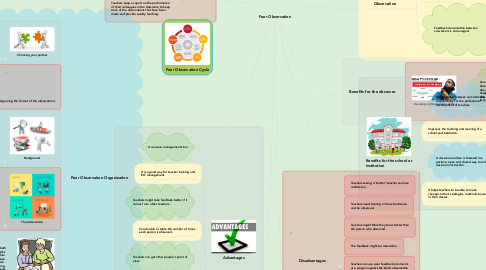
1. Peer observation is when a teacher observes another teacher in order to develop their classroom practice.
2. What is peer observation?
3. Peer Observation Cycle
4. Quality control
4.1. Teachers keep a report on the performance of their colleagues in the classroom to keep track of the observations that have been made and provide quality teaching.
5. Peer Observation Organization
5.1. Choosing your partner
5.1.1. The teacher can choose who will be her observer because she will feel confident if she is someone known, who is responsible, respectful, and above all who is honest, resulting in a good observation from colleague.
5.2. Agreeing the format of the observations
5.2.1. The teacher together with his colleague agree on which will be the focus of the observation during the class, the teacher has the opportunity to ask his colleague who will observe him to identify the errors, how to apply the methods, to see the areas that need improvement .
5.3. Background
5.3.1. The teacher informs the observer about the students he attends, the content of the class, so that the observer has an idea of what he is going to verify and observe.
5.4. The observation
5.4.1. The observer takes notes, notes, corrections that she writes while the teacher develops the class with her students, and then the observer has a feedback meeting with her partner.
5.5. Follow-up
5.5.1. After passing the observation process, both parties should meet to clarify the strengths and weaknesses that the teacher had while teaching the class, his partner should make him notice where he was good and where he needs to improve, to improve teaching, and it is better when both teachers already have experience as observers.
5.6. Confidentiality
5.6.1. Both teachers, that is, the teacher who will observe how the teacher who will be observed must take into account that all comments, notes, advice will remain between them, because it is important that this information is confidential, and for professional ethics, because it is not correct to disseminate the mistakes of other co-workers.
6. Advantages
6.1. It can save management time
6.2. It is a good way for teacher training and ELT management.
6.3. Teachers might take feedback better if it comes from other teachers.
6.4. Can double or triple the number of times each person is observed.
6.5. Teachers can get other people's point of view.
6.6. The person being observed and the person observing learn
6.7. It makes the teachers understand how difficult observing and feedback can be
6.8. It can boost a teacher's confidence.
7. Benefits of Peer Observation
7.1. Provides opportunities for professional development.
7.1.1. The teacher applies what he learned through peer observation, also uses this process to receive constructive criticism for professional development.
7.2. Peer Observation
7.3. Feedback conversation between co-workers is encouraged.
7.3.1. The conversation between peers collects important information to encourage an honest conversation with the purpose of increasing the abilities, skills, strategies, dialogue, knowledge to develop good teaching in the classroom, using the peer observation process.
8. Benefits for the observer
8.1. Develop communication skills
8.1.1. An observer has the opportunity to develop communication through a discussion of teaching and learning that helps constructive feedback, in addition an observer uses the observations of others to improve his teaching.
